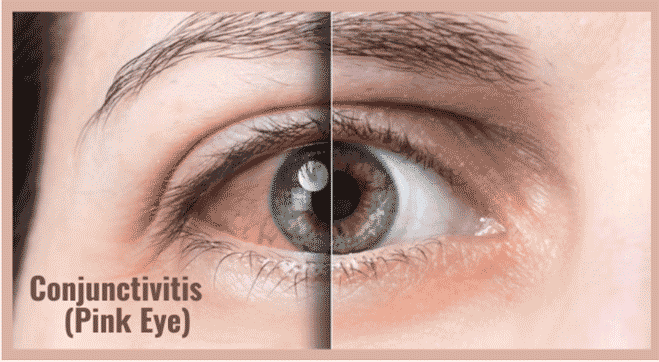What Is Conjunctivitis?
Conjunctivitis also known as Pink Eye is an infection or inflammation of the conjunctiva, a thin, clear membrane that protects your eyes. As the blood vessels in the conjunctiva become swollen and irritated, your eyes appear red or pink and secrete a sticky discharge. It may happen in one or both of your eyes. Conjunctivitis, especially Neonatal Conjunctivitis (conjunctivitis in babies), can be highly contagious as they are more likely to rub their eyes and pass on the contamination to their friends and other loved ones. Timely madras eye treatment and precautions can help manage the discomfort of pink eye, helping limit bacterial or viral infection.
Did you know:
India is currently witnessing a spike in the number of cases of conjunctivitis. AIIMS Delhi has reported more than 100 patients witnessing the infection every day. This spur in conjunctivitis cases has made it a global health concern. In the wake of the rising cases, the Tamil Nadu health department has asked people to be watchful of the highly infectious “Madras Eye”.
- Delhi-NCR: One private eye care hospital in Delhi reported 1,032 cases of conjunctivitis in Delhi-NCR and 1,521 cases PAN India.
- Gujarat: Since June, Gujarat has witnessed 2.17 lakh (217,000) cases of conjunctivitis.
- Maharashtra: In July, Maharashtra saw a staggering 87,761 conjunctivitis cases, making it one of the most severe outbreaks in recent years.
- Karnataka: Between July 25 and August 4, Karnataka recorded 40,477 cases of conjunctivitis.
What Is Madras Eye?
Want to know why conjunctivitis is called madras eye? The Madras Eye Infection was diagnosed in Chennai at the King Institute of Preventive Medicine and Research in 1918. The infection was caused due to a virus called adenovirus, first detected in Madras and so got the name Madras Eye. As the infection quickly spreads, doctors recommend avoiding touching the eyes with dirty hands to prevent Madras Eye.
How Does Conjunctivitis Spread?
Infectious conjunctivitis is caused by viral or bacteria that lead to infection in the blood vessels of the conjunctiva. Touching your eyes frequently with dirty hands or coming in contact with objects that are contaminated with such viruses or bacteria can also cause pink eyes. More likely, it can also advance through respiratory tract droplets. Allergic conjunctivitis is not contagious or transferable. While neonatal conjunctivitis is passed from an infected mother to her newborn during childbirth. Fungal conjunctivitis is rare and not highly contagious.
Types Of Conjunctivitis
In general, there are three types of conjunctivitis, depending on what triggers the infection. Bacterial and viral conjunctivitis are contagious, spreading from one person to another. However, allergic conjunctivitis is non-contagious.
Allergic Conjunctivitis
This type of conjunctivitis is an allergic reaction to environmental substances like cigarette smoke, pollen, pool chlorine, car fumes, etc. Allergic conjunctivitis is a seasonal infection. It is also possible to have giant papillary conjunctivitis (another type of allergic pink eye) if you wear infected hard contact lenses or soft contact lenses. Most often, allergic reactions to these foreign substances may become the reason for conjunctivitis, leading to watery discharge from the eyes. So, if you’re prone to seasonal allergies, using eyeglasses is the best thing to keep this infection at bay.
Giant Papillary Conjunctivitis:
Often associated with contact lens wear, this condition is characterised by the formation of large bumps (papillae) on the inside of the eyelids. It can cause itching, redness, and discomfort in the eyes.
Infectious Conjunctivitis
Viral Conjunctivitis or Bacterial Conjunctivitis is highly spreadable and is the most common type of conjunctivitis. They usually begin in one eye, causing watery discharge, and from there, it may transfer to the other eye within a few days. In many cases, viral conjunctivitis symptoms may develop along with respiratory infections, such as sore throat or cold. The common viral or bacterial conjunctivitis symptoms include a burning sensation, watery or faecal discharge, and red eyes.
Chemical Conjunctivitis
Chemical Conjunctivitis is similar to allergic conjunctivitis. It develops when chemicals or smoke causes inflammation in the blood vessels of the conjunctiva. The best way to prevent this type of conjunctivitis is to wash your eyes as soon as the toxic chemical or liquid comes in contact with your eyes. Chlorine water in swimming pools is the most common toxic liquid that may cause chemical conjunctivitis or mild pink eye. You can adopt a conjunctivitis cure regimen by avoiding exposure to these environmental and chemical irritants.
Gonococcal Conjunctivitis:
Gonococcal conjunctivitis is a rare but serious type of conjunctivitis caused by the bacterium Neisseria gonorrhoeae, which is also responsible for the sexually transmitted infection gonorrhoea. This type of conjunctivitis can occur in newborns during childbirth if the mother is infected with gonorrhoea. It can also affect adults through direct contact with infected genital secretions, usually during sexual activity or by touching contaminated surfaces and then touching the eyes.
Chlamydial Conjunctivitis:
Chlamydial conjunctivitis is caused by the bacterium Chlamydia trachomatis and is typically associated with a genital infection. Like gonococcal conjunctivitis, it can also be transmitted to newborns during childbirth if the mother has a chlamydial infection. It’s important to note that this type of conjunctivitis can also occur in adults who engage in sexual activity with an infected partner.
Neonatal Conjunctivitis:
Neonatal conjunctivitis is a type of eye infection that affects newborn infants. It occurs within the first few weeks of life and can result from various factors, including infections acquired during childbirth. This condition is sometimes referred to as “ophthalmia neonatorum.”
Symptoms of Conjunctivitis: How do you know if you have Conjunctivitis?
How to know if you have pink eyes? If you’re experiencing any of the following symptoms, there’s a chance you might be dealing with pink eye. The early pink eye symptoms may include:-
- Pink or red eyes
- Watery or thick discharge, which looks like mucus, usually at night
- Itchiness in your eyes
- Abnormal amount of tears
- Burning or itching eyes
- Pain in the eyes
- Puffy eyelids
- Blurry or hazy vision
- Extra sensitive to light
If your madras eye symptoms do not get better in 12-24 hours, make an appointment with your doctor right away.
Causes of Conjunctivitis
The most common madras eye causes include:
- Viruses or bacteria: Viruses like adenoviruses, common cold viruses, or herpes simplex virus can lead to viral conjunctivitis and Bacteria such as Staphylococcus aureus, Streptococcus pneumoniae, or Haemophilus influenzae can cause bacterial conjunctivitis.
- Exposure to allergens like pollen: Allergens like pollen, dust mites, or pet dander can trigger allergic conjunctivitis.
- Chemical Exposure: Exposure to harsh chemicals can cause chemical conjunctivitis.
- Blocked Tear Ducts: In newborns, a blocked tear duct
- Contact Lenses: Prolonged contact lens wear might cause giant papillary conjunctivitis due to irritation.
- Autoimmune Conditions: Conditions like rheumatoid arthritis or systemic lupus erythematosus can occasionally trigger conjunctivitis.
- Chlamydia and Gonorrhea: These sexually transmitted infections can cause conjunctivitis, particularly in newborns.
Complications And Risk Associated With Conjunctivitis
The possible complications of Conjunctivitis include:
- Meningitis – an infection of the cells surrounding the brain and spinal cord.
- Cellulitis– an infection in the skin’s deep layers, causing the surface to become inflamed.
- Infection– viral or infectious conjunctivitis may spread from one person to another, making it a national epidemic.
- Corneal Involvement: In severe cases of conjunctivitis, especially bacterial or viral types, the infection can spread to the cornea, the transparent front layer of the eye. Corneal involvement can lead to corneal ulcers, which may affect vision if not properly managed.
- Eyelid Inflammation: Inflammation of the eyelids (blepharitis) can sometimes accompany conjunctivitis, leading to additional discomfort and irritation.
How Is Pink Eye Diagnosed?
Your doctor will be able to diagnose pink eye or madras pink eye by simply looking at the symptoms. They will ask you general questions to know your condition better; this is a part of the physical examination. For instance, they may ask if you’re suffering from a common cold or allergic reaction such as hay fever or asthma.
Your doctor may also conduct a few tests, which include:
- A vision test to see if your vision has been affected
- Examination of the conjunctiva using bright light and magnification
- Examination of the inner eye to check if the tissues are working properly
- Conjunctival tissue smear to rule out any infection in the conjunctiva.
Conjunctivitis Treatment
Want to know how to cure pink eyes? Well, the pink eye treatment may depend on the type of infection you’re experiencing.
Medical Treatments
- Bacterial conjunctivitis: This type of conjunctivitis is best treated with antibiotics or conjunctivitis medications and conjunctivitis eye drops. For children, an ointment might be a better alternative to medication.
- Chemical conjunctivitis: The conjunctivitis recovery time is less compared to other forms of conjunctivitis. This type of acute conjunctivitis can get better by rinsing off your eyes with saline water. Your doctor may also prescribe topical steroids to reduce watery discharge or soothe redness.
- Viral conjunctivitis: If a cold or respiratory infection is the cause, then likely viral conjunctivitis may get better with the same medications or antibiotics you are taking for treating the cold. The signs usually get better within 7 to 10 days. In the meantime, you can use a warm compress to soothe signs. Seek immediate treatment for viral conjunctivitis if the symptoms persist and get worse.
- Allergic conjunctivitis: For treating allergic conjunctivitis, your healthcare provider is likely to recommend an antihistamine to counter the inflammation.Over-the-counter options like Loratadine (Claritin) and diphenhydramine (Benadryl) are antihistamines that could alleviate your allergic symptoms, including those of allergic conjunctivitis. Additional treatments involve the use of antihistamine eye drops or anti-inflammatory eye drops.
Home Remedies For Conjunctivitis
If you have viral or bacterial conjunctivitis, there is no treatment. The body heals itself in a couple of days, attacking the virus on its own. However, you can reduce the effects by following conjunctivitis prevention measures and these home remedies:-
- Using a damp, warm washcloth to cover your eyes for a couple of minutes
- Soak a clean cotton cloth in warm water, then squeeze it out, dripping the water. Lay the cloth over your eyes until your eyes feel relaxed. You can do this multiple times a day
- Use a different washcloth every time you use it on your eyes. This will also loosen the dried mucus
- Take antibiotics regularly as prescribed by your doctor
- Artificial tears may also help
Read More: 10 Superfoods for Improved Eyesight and Ocular Health
Conjunctivitis Transmission : How Do You Pevent Conjunctivitis From Spreading?
Viral and Bacterial conjunctivitis are contagious, so following certain preventive measures can help slow down the risk of infection of conjunctivitis in kids and adults.
Here are some tips on conjunctivitis or madras eye infection prevention:-
- Use a clean cotton towel or tissue to wipe your face and eyes.
- Wash your hands often with a hand wash. Wash your hands before and after your meals or when you sneeze or cough to stop contamination.
- Do not touch your eyes too often, especially if you are in a crowded place.
- Bacteria may also be present in your makeup products, so don’t be tempted to use anyone’s makeup products, such as kohl, kajal, or mascara. Never share your makeup with others.
- Do not use old contact lenses, Replace your contact lenses regularly, especially when the infection has spread.
Sources
Ref Links:
- https://www.aao.org/eye-health/diseases/pink-eye-conjunctivitis
- https://www.healthline.com/health/conjunctivitis
- https://www.webmd.com/eye-health/eye-health-conjunctivitis
- https://www.livemint.com/science/what-explains-the-pink-eye-outbreak-in-india-11690974768711.html
- https://www.hindustantimes.com/cities/delhi-news/amid-heavy-rainfall-delhi-ncr-sees-surge-in-conjunctivitis-cases-aiims-reports-100-cases-a-day-101690339746280.html
- https://indianexpress.com/article/cities/baroda/2-17-l-conjunctivitis-cases-since-june-8873843/
- https://www.financialexpress.com/healthcare/news-healthcare/conjunctivitis-cases-continue-to-surge-in-india-heres-what-you-need-to-know/3199009/
- https://indianexpress.com/article/cities/bangalore/karnataka-recorded-over-40000-cases-of-conjunctivitis-between-july-25-and-august-4-health-dept-data-8882675/









